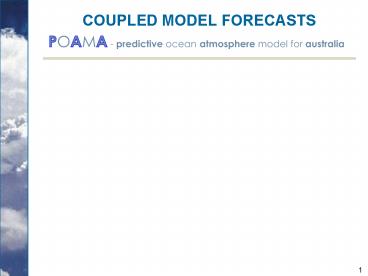COUPLED MODEL FORECASTS - PowerPoint PPT Presentation
1 / 17
Title:
COUPLED MODEL FORECASTS
Description:
Coupled model incorporates real time observations of ocean and atmosphere ... Statistical models are prone to inflated skill estimates due to artificial skill. ... – PowerPoint PPT presentation
Number of Views:45
Avg rating:3.0/5.0
Title: COUPLED MODEL FORECASTS
1
COUPLED MODEL FORECASTS
2
CURRENT SYSTEM OF SEASONAL FORECASTS
Based on a statistical analysis Eg Seasonal
outlook of rainfall
Forecast confidence
3
POAMA DYNAMIC SEASONAL FORECASTING
- POAMA outline
- Coupled model incorporates real time
observations of ocean and atmosphere - Produces daily forecasts
- Many variables
- Issues daily values for a 9-month period
- Aim
- To compare POAMA forecast model results with
those from current statistic based model - If they show an improvement then they will
replace the current system
4
POAMA DYNAMIC SEASONAL FORECASTING
- Shift to dynamical models why move from
statistical models? - Statistical models capture only a subset of
predictability due to very limited training
period. This is largely El Niño/La Niña. - Statistical models are prone to inflated skill
estimates due to artificial skill. - Statistical models are prone to invalidation due
to climate change. - May put an end to the seasonal outlook cottage
industry
5
POAMA DYNAMIC SEASONAL FORECASTING
- Use physical equations to project
atmosphere/ocean forward in time. - Consist of a weather prediction model coupled
with an ocean/land/ice model. Anything observed
can in theory be predicted, e.g., rainfall,
streamflow, evaporation. - The models are potentially immune to climate
change, provided forcings such as ozone and CO2
are adequately represented (in contrast to
statistical models).
6
The Operational POAMA System
Observing network
Obs/data Assimilation
Model
Forecast/products
Daily NWP Atmos. IC
Real-time ocean assimilation latest ocean/ atmos
obs 9-month forecast once per day Ensemble
forecasts
Atmos. Model T47 BAM (unified)
Atmospheric observations
Coupler OASIS
Ocean observations
Ocean assimilation - Temp. OI every 3 days
current corrections
Ocean Model ACOM2 (MOM2)
7
POAMA DYNAMIC SEASONAL FORECASTING WHERE WE ARE
AT
Initial analysis of experimental version of POAMA
8
POAMA DYNAMIC SEASONAL FORECASTING WHERE WE ARE
AT
Initial analysis of experimental version of POAMA
9
POAMA DYNAMIC SEASONAL FORECASTING WHERE WE ARE
AT
Initial analysis of experimental version of POAMA
10
POAMA DYNAMIC SEASONAL FORECASTING WHERE WE ARE
AT
Using model output to forecast ENSO state
NINO3 temperature anomalies averaged over
NOVEMBER is as followsbelow 0.8C (La Niña)
0 0.8C to zero (Neutral) 31 zero to
0.8C (Neutral) 63 above 0.8C (Warm) 6
And similarly for FEBRUARY 2005 the results
arebelow 0.8C (La Niña) 0 0.8C to zero
(Neutral) 13 zero to 0.8C (Neutral)
72above 0.8C (Warm) 15
11
POAMA DYNAMIC SEASONAL FORECASTING WHERE WE ARE
AT
Developing first operational page
Outlook for June 2004
12
Soon-to-be public POAMA webpage
13
Nino 3.4 of 97/98 El Nino
Forecasts starting 1st Dec 1996 SOI 7.2
14
Nino 3.4 of 97/98 El Nino
Forecasts starting 1st Dec 1997 SOI -9.1
15
Decay of 2002 El Nino POAMA Real-time forecasts
16
Decay of 2002 El Niño
POAMA
ECMWF
NCEP
NASA
17
POAMA DYNAMIC SEASONAL FORECASTING WHERE WE ARE
GOING
- Analysis of new model (POAMA2) expected late
2005 - Streamlining of operational products on new
computer systems - Developing procedures to provide probabilistic
type forecasts of rainfall and temperature - Verification of forecasts and comparison with
statistical forecast - Further development of operational products
- Developing web pages and methods to present the
forecasts - Education and obtaining feedback
- Providing climate forecast data to outside parties































